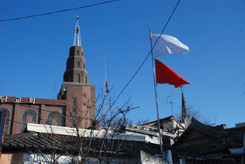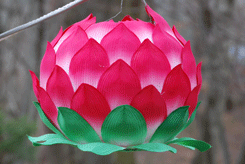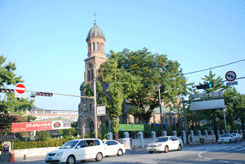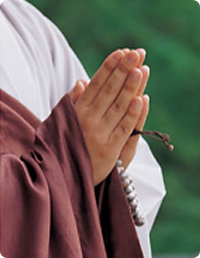Religion
 |
 |
 |
The Buddhist and Christian religious faithful form two of Korea’s largest spiritual communities, and both came by way of China. Buddhism entered Korea in the 4th century and Christianity in the late 1700s. But before Koreans accepted these foreign imports, Korean shamanism was the dominant religion on the peninsula. From the 14th century, Confucianism flourished. While it is a very ethnically homogenous society, Korea's religious diversity is unique. Among Christians, there is quite a bit of diversity. While the dominant denomination is the Presbyterian Church in Korea, there are Methodists, Baptists, Lutherans, the Assemblies of God, and others. The Roman Catholic Church has been in Korea for over 200 years. Additionally, there is a small Orthodox presence. There are several Buddhist sects. Korean shamanism continues to survive. However, even into the modern era, Korea has developed its unique religious traditions. One of the most significant Korean religions of the 20th century is Cheondoism. Buddhists and Protestants account for 23 percent and 19 percent respectively, 11 percent practice the Catholics and 2 percent of the nation's population have other religions.
Buddhism
Buddhism was first reached Korea in AD 372 in the form called Mahayana, or the Great Vehicle. First accepted by Goguryeo (BC 37-AD 668) and then in Baekje (BC 18-AD 660) in AD 384. The new faith spread rapidly through the two kingdoms as it apparently received royal patronage. However, it was rejected by the Silla (BC 57-AD 935) government until around 527 when the royal family adopted it as the state religion because of alleged miracles performed by Lee Chadon. It became a powerful influence and eventually an integral part of Korean culture. It reached its peak in the Goryeo kingdom (928-1392). With the establishment of the Joseon (1392-1910), it fell into disfavor and was suppressed in favor of Confucianism. Korean Buddhism believes in individual immortal souls, a vicarious salvation through Amitahba Buddha, reincarnation, confession, hell, and heaven, the Western Pure Land and Nirvana. They believe that to pass from this world of misery to that of heaven the six virtues of charity, morality, patience, energy, contemplation, and wisdom must be perfected.
Confucianism
Confucianism is an ethical and philosophical system, on occasion described as a religion, developed from the teachings of the Chinese philosopher Confucius (551?479 BCE). He provided few specific moral principles. One should obey one's elders and superiors and treat rulers, parents, and even those who were not one's social equals with respect. One should also respect ritual, cultivate wisdom, be trustworthy, and strive to do the right thing in any situation.
Confucianism focuses on the practical order inscribed in a this-worldly awareness of the Heaven and a proper respect of the gods, with particular emphasis on the importance of the family, rather than on a transcendent divine or a soteriology. This stance rests on the belief that human beings are teachable, improvable, and perfectible through personal and communal endeavor especially self-cultivation and self-creation. Confucian thought focuses on the cultivation of virtue and maintenance of ethics. Some of the basic Confucian ethical concepts and practices include:
Confucian ethics is characterized by the promotion of virtues, encompassed by the Five Constants (五常), extrapolated by Confucian scholars during the Han Dynasty. The Five Constants are:
Humaneness (仁) is an obligation of altruism and humaneness for other individuals.
Righteousness or justice (義) is the upholding of righteousness and the moral disposition to do good.
Proper rite (禮) is a system of ritual norms and propriety that determines how a person should properly act in everyday life and embodies the entire web of interaction between humanity, human objects, and nature. It has also been translated as "custom", "mores", and "rules of proper behavior", among other terms.
Knowledge (智) is the ability to see what is right and fair, or the converse, in the behaviors exhibited by others. Confucianism holds one in contempt, either passively or actively, for the failure of upholding the cardinal moral values of humaneness and righteousness.
Integrity or Credibility (信) is concerned primarily with commitments in which verbal (or other) representations have been made, whereas trust can exist. It comes about as a result of moral cultivation, and which crowns the moral development.
These are accompanied by the classical Sizi (四字), that singles out four virtues, one of which is included among the Five Constants.
(忠, loyalty),
(孝, filial piety),
(節, continence),
(義, righteousness).
There are still many other elements, such as honesty (誠), kindness and forgiveness (恕), kindness and forgiveness, honesty and cleanness (廉), shame, judge and sense of right and wrong (恥), bravery (勇), kind and gentle (溫), good and kindhearted (良), respectful and reverent (恭), frugal (儉), modestly and self-effacing (讓)
Loyalty
Loyalty (忠) is particularly relevant for the social class to which most of Confucius' students belonged, because the most important way for an ambitious young scholar to become a prominent official was to enter a ruler's civil service, especially loyalty to a ruler on the part of a minister.
Filial piety
In Confucian philosophy, filial piety (孝) is a virtue of respect for one's parents and ancestors. Filial piety is central to Confucian role ethics. In more general terms, filial piety means to be good to one's parents; to take care of one's parents; to engage in good conduct not just towards parents but also outside the home so as to bring a good name to one's parents and ancestors; to perform the duties of one's job well so as to obtain the material means to support parents as well as carry out sacrifices to the ancestors; not be rebellious; show love, respect and support; display courtesy; ensure male heirs, uphold fraternity among brothers; wisely advise one's parents, including dissuading them from moral unrighteousness; display sorrow for their sickness and death; and carry out sacrifices after their death. In its purest essence, Confucianism is a social system rather than a religion.
Confucianism exerted a strong influence on social and governmental institutions, but it was not until the establishment of the Joseon dynasty and her ousting of Buddhism from political influence in the late fourteenth century that Confucianism, rather Neo-Confucianism, was elevated to the status of a state cult. Education in the Chinese classics, particularly the writings of Confucius became the sole basis of education and erudition represented the only path to social and political success. Although Confucianism no longer dictated the government system, it thrives more in Korea than in any other Asian nations. Its basic values and premises still dominate the lives of Koreans. Ancestor veneration continues to be practiced in much the same way it has been for centuries.
Catholicism
The Korean Catholic church was established on the initiative of Koreans before foreign missionaries entered the country. This may make Korea unique within the entire history of Christianity. Korean Christianity dates back to the 18th century, when Korean scholars heard about the spread of the faith in China. They traveled to China to study the Christianity under Jesuit missionaries. They returned to their homeland to teach the faith, gaining thousands of converts even in the absence of priests. A group of young Confucian scholars by the name of Yi Byeok, Gwon Il-sin and Yi Ga-hwan along with Jeong Yak-jong and his two brothers converted to Catholicism after reading Catholic doctrinal texts that had been sent from Beijing. In 1783, Yi Seung-hun was sent to Beijing where he became the first to receive baptism. On his return to Korea, he and the other converts established Korea's first Catholic Church at the residence of Kim Beom-u in Seoul. After this amazing beginning, Korean authorities began to persecute Christians and prohibited Catholic books. Korean Catholics were severely persecuted and many martyred by the government due to their refusal to participate in ancestral rites. Eventually, with the signing of a friendship treaty with the United States in 1882, Korean Catholics gained freedom to carry out church activities. In May of 1984 during the bicentennial commemoration of Korean Catholicism, Pope John Paul II canonized 103 of Korea's martyrs, making the country fourth in the world in the total number of saints. On August 16, 2014, Pope Francis beatified 124 Korean martyrs in Seoul.
Protestantism
The history of Protestantism in Korea begins with Horace Allen, an American Presbyterian (Northern) missionary who arrived in Korea in 1884. Horace G. Underwood of the same denomination and the Methodist Episcopal (North) missionary, Henry G. Appenzeller, came from the United States the next year. From the beginning, Protestant missions simultaneously performed evangelical and social work. By establishing the country's first Western medical clinics and introducing a modern school system, these missionaries played a leading role in bringing the modern social institutions of the West into Korean society. The results of their efforts are manifold. For example, many modern national leaders came out of schools operated by the missionaries. These leaders, with their international perspective, were able to develop an anti-Japanese independence movement during the occupation.
Shamanism
Nature and spirits are worshiped.
The sun, the moon, stars, mountains seas, rivers, rocks and trees are all objects of worship. One of the most dominant features of Korean Shamanism today is its deep belief in the soul of dead. The spirits of ancestors, people who died harboring grudges and deep resentment, and those who died untimely deaths are honored in worship. Together with nature spirits, Taoist deities, and reincarnated Buddhist deities, these souls fill the pantheon of Korean Shamanism. the Korean people have traditionally believe that the spirits of those who died young, who were murdered, or who died before fulfilling their dreams could play havoc with the living with diseases or great misfortune. the spirit of the dead, especially those of the dead who died harboring grudges, are thus very carefully treated with a help of Mudang, Shaman expert. Mudang dissolves conflicts and tensions that are believed to exist between the dead and the living by reconciling the two.
The Gut, a Shaman ritual, is performed in honor of gods and spirits. A lavish feast table is then arranged. Gut has a very obvious purpose to free people of diseases and misfortunes by praying to gods and spirits. It is above all an exorcism to chase away diseases and bad luck. Koreans do not regard Gut as an entirely religious performance. It is a dramatic performance with strong theatrical overtones that rely heavily on dance and music. During a Gut, a Mudang takes on many roles, changing from an actress performing with invisible fellow performers to one performing a solo pantomime, to a dramatic dancer to an acrobat. A Gut may be performed anywhere, at home, at the site of an accident, or in a performing arts center. It is both a religious and a ceremonial feast that people attend to have a good time as much as to pray. A Shaman is believed to possess supernatural power once she becomes possessed by a spirit in the course of a Gut and she demonstrates her state through acrobatic acts. Such power is demonstrated when she dances barefoot on a pair of sharpened huge knives placed side by side. Beliefs in spirits, including the spirits of ancestors, is well illustrated by a Gut, which is performed to pacify a troubled spirit, or wandering black soul, who refuses to travel to the other world for their deep attachment to life in this world.
The Mudang placates these unhappy souls and sent to the world of the dead by performing Gut. The Gut takes from one to three days to complete. Important scenes include the possession of the Shaman by a dead soul, and introduction to the deity who will take the wandering spirit to the world of the dead, and the departure of the cleansed spirit to the other world after bidding a last farewell to family members and beloved ones. After being possessed by spirit, the Shaman recounts all its sad and hard experiences in a monologue with dance and songs. The Shaman herself cries over the suffering the dead experienced in this world and the family members and neighbors gathered to watch the Gut are moved to tears. The Shaman displays a long knotted piece of cloth, the knots being symbolic of the psychological wounds sustained by the subject of the Gut when alive. In Korean language, suffering and grudges are knotted and should be dissolved or untied. The Shaman unties the knots in the piece of clothes as she recounts the sufferings and frustrations of the subject. Family members pray that what the subject had wished for will come true or promise that they will help him realize his wishes, thus heightening the dramatic effect of untying the knots. The Shaman then sprinkles a doll dressed in the clothes of the dead person with water with mugwort in it. This is a libation and baptism of the subject of the Gut, signifying freedom from past wounds and sufferings.
Village sanctuary
Traditionally, most of the Korean villages had their own sanctuaries. The following religious objects like Seondol, Doltap, Jangseung or Sotte, can be found separately or together at the sanctuary. Seondol or a menhir is a divine stone signifying the boundary of a village. It also symbolizes protection and a good harvest. Doltap, a stone pagoda, is an altar where the village god dwells. Jangseung is a divine wooden pole signifying the boundary of the village. It wards off bad luck and prevents epidemics. Sotte is a symbolic passage way where all gods go up to and down from the heaven. The wooden duck atop symbolizes good harvest and fertility.
Seonangdang
Seonangdang with its Dangnamoo, a giant old tree, is a home for all gods which bring protection, prosperity and fertility. They ward off bad luck and bring good fortune. Seonangdang is an altar performing a sacrificial rite for a tutelary deity, which is also called in such a name as Songwhangdang, Halmidang, Kuksadang or Chonwangdang. Seonangdang shows a single or a complex form as a tree where a tutelary deity dwells, a pile of stones or a shrine. This Seonangdang is enshrined with a tutelary deity as a chief god in the form of its painting or a memorial tablet of deity. This religion of Song has functions not only to protect the village from misfortunes, diseases or calamities, but to pray a good harvest. On the first day of the lunar New Year, or in the spring or fall, the whole villages assemble here and make sacrifices for public peace, order and prosperity. Moreover, an individual can hold a ritual here at any time for good fortune.
Divination and Fortunetelling
Divination is the practice of attaining a certain goal with help from supernatural powers. It was performed as a seasonal custom, but more frequently for the purpose of preventing or curing diseases relying on the ability of shamans to communicate with the supernatural world. Talismans were also used to expel evil spirits or misfortunes. Fortunetelling was also widely practiced during Joseon period, and is still continued on.






